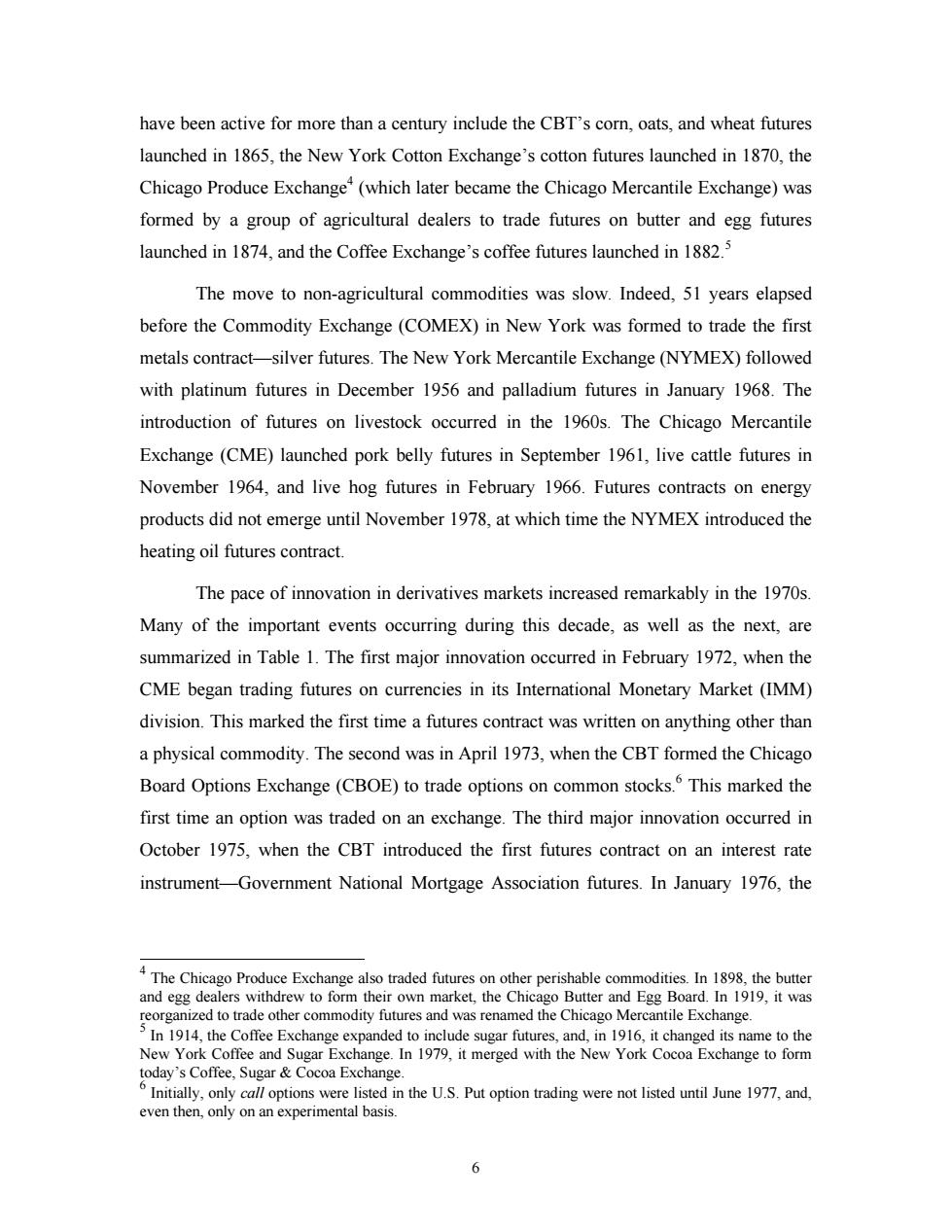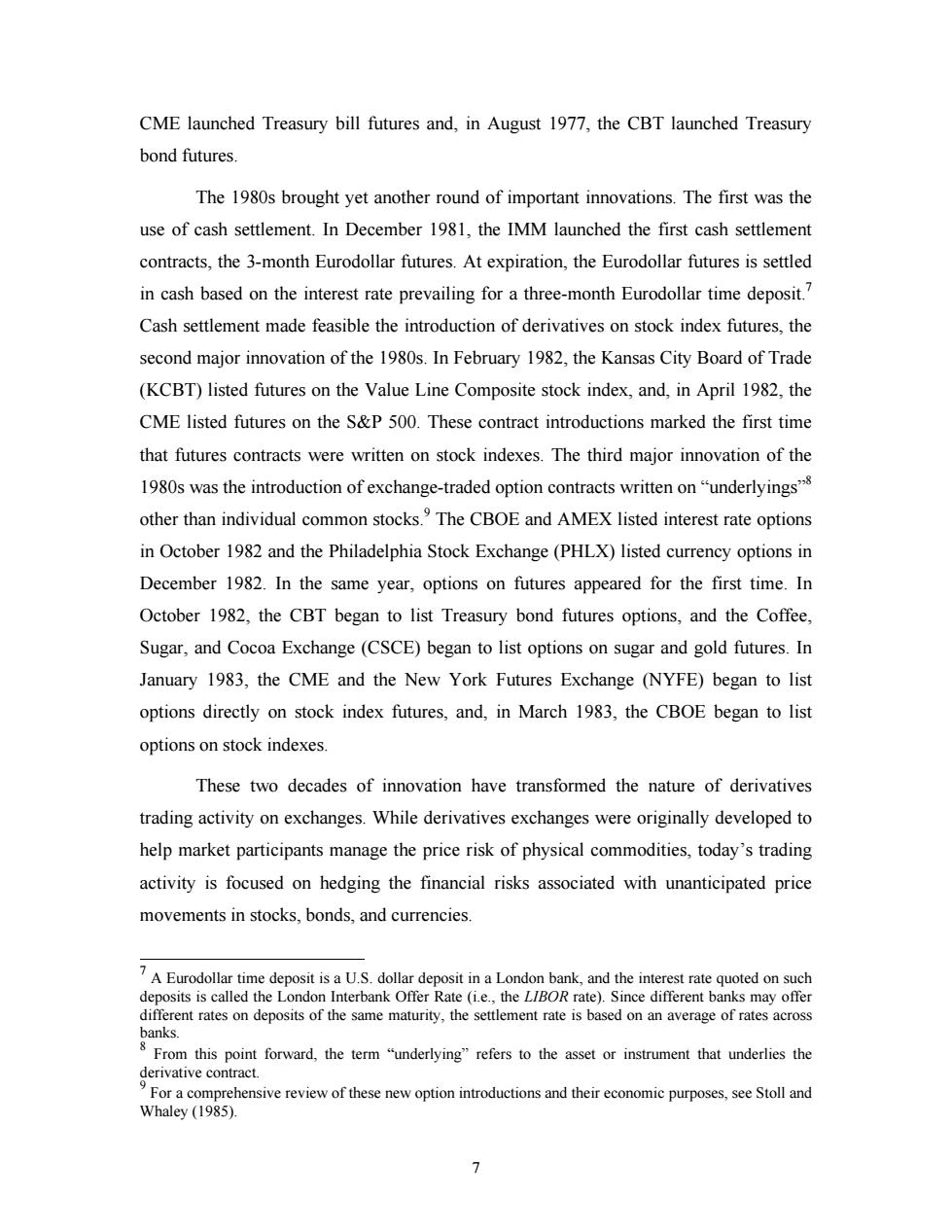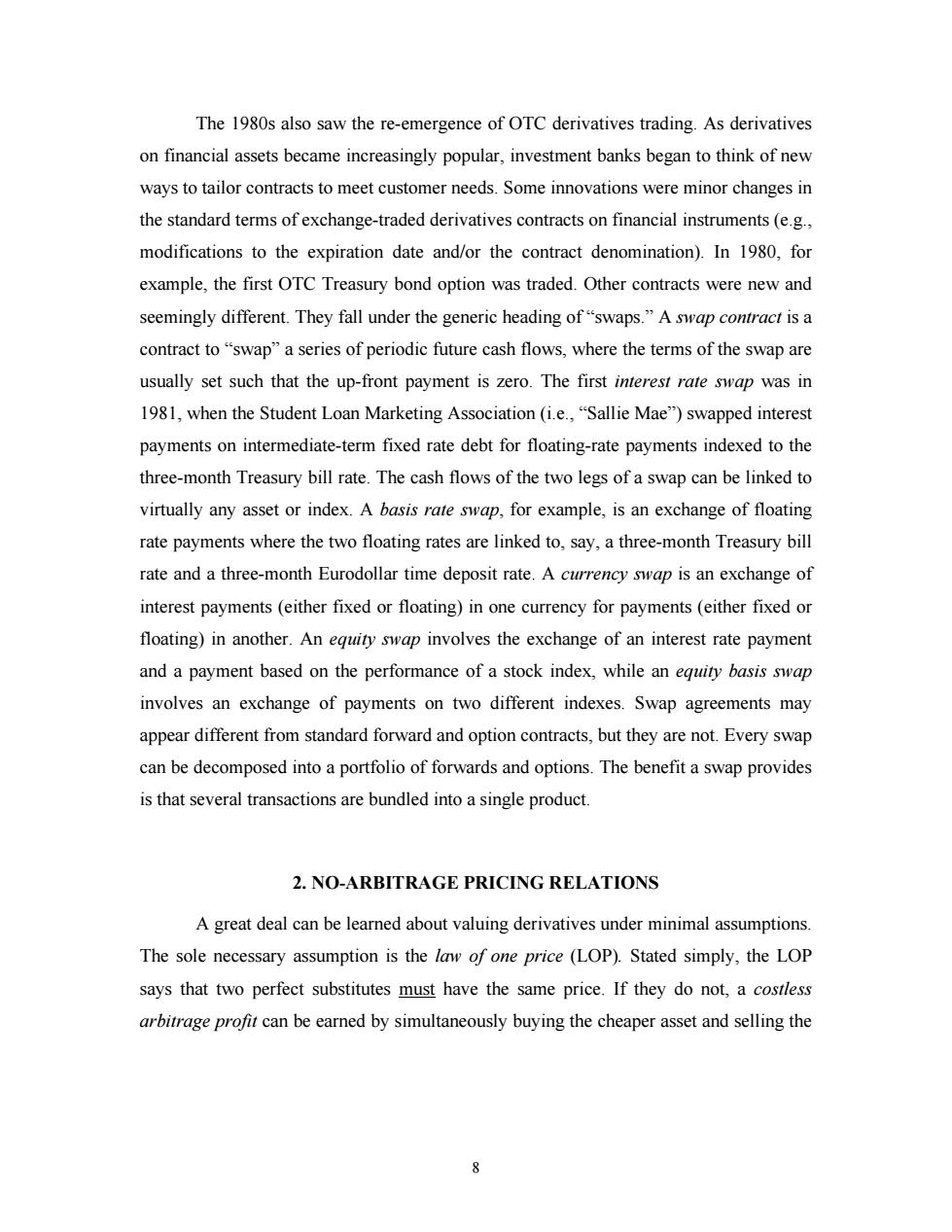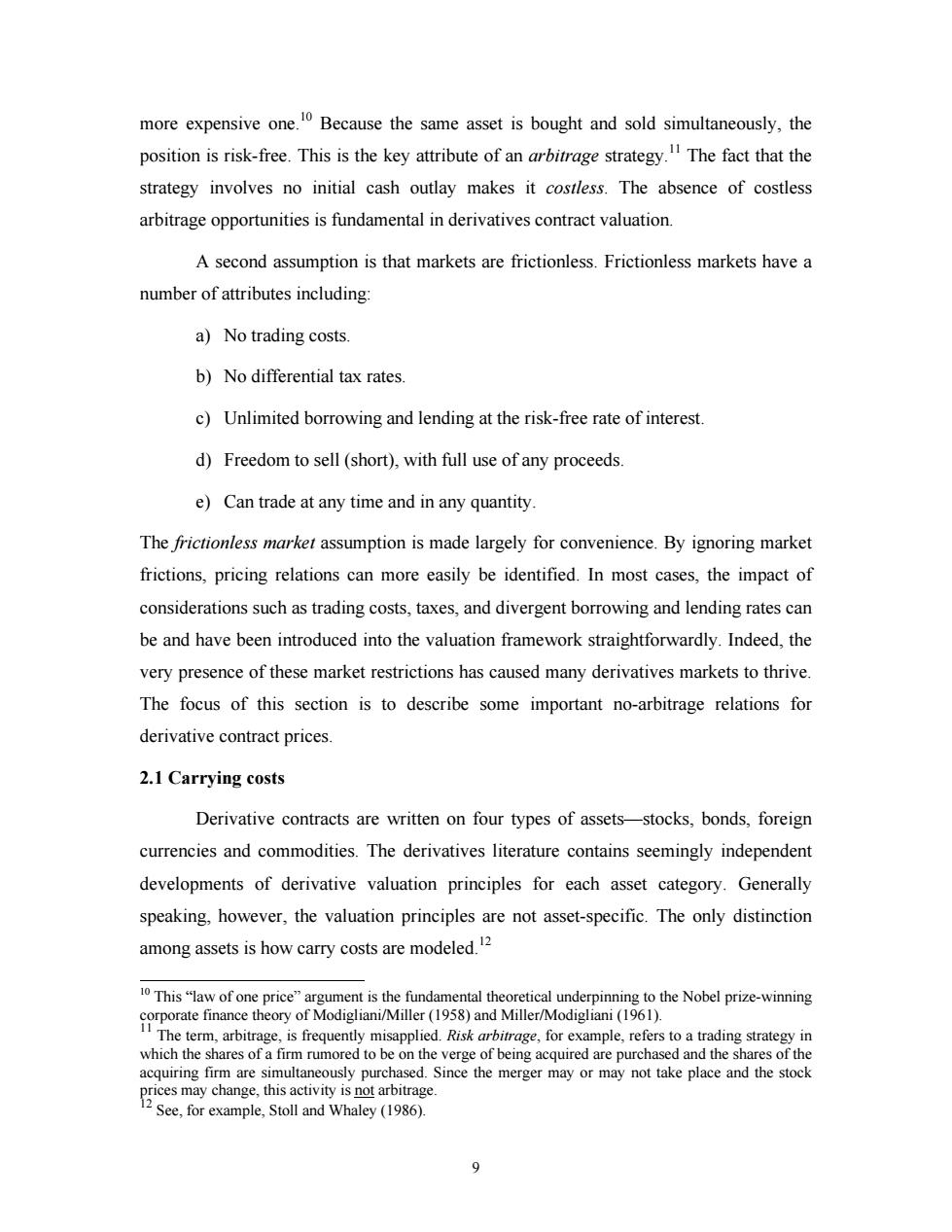
one cent per bushel below the March 13h spot price.3 Forward contracts had their drawbacks,however.They were not standardized according to quality or delivery time. In addition,like in the case of the tulip bulb fiasco,merchants and traders often did not fulfill their forward commitments. In 1865,the CBT made three important changes to the structure of their grain trading market.First,they introduced the use of standardized contracts called futures contracts.Unlike forwards contracts in which the parties are free to choose the terms of the contract,the terms of futures contracts are set by the exchange and are standardized with respect to quality,quantity,and time and place of delivery for the underlying commodity.By concentrating hedging and speculative demands on fewer contracts,the depth and liquidity of the market are enhanced.This facilitates position unwinding.If a party to a trade wants to exit his position prior to the delivery date of the contract,he need only execute an opposite trade(i.e.,reverse his trade)in the same contract.There is no need to seek out the counterparty of the original trade and attempt to negotiate the contract's termination. The second and third changes were made in an effort to promote market integrity. The second was the introduction of a clearinghouse to stand between the buyer and the seller and guarantee the performance of each party.This crucial step eliminated the counterparty risk that had plagued OTC trading.In the event a buyer defaults,the clearinghouse"makes good"on the seller's position,and then holds the buyer's clearing firm liable for the consequences.The buyer's clearing firm,in turn,passes the liability onto the buyer's broker,and ultimately the buyer.Note that,at any point in time,the clearinghouse has no net position since there are as many long contracts outstanding as there are short.The third was the introduction of a margining system.When the buyer and seller enter a futures position,they are both required to deposit good-faith collateral designed to show that they can fulfill the terms of the contract. From the late 1800s through the early 1980s,the majority of derivatives trading took place on exchanges.Futures contracts were the dominant contract design,and agricultural commodities were the dominant underlying asset.The list of contracts that 3 See Chicago Board of Trade(1994,ch.1,p.14) 5
one cent per bushel below the March 13th spot price.3 Forward contracts had their drawbacks, however. They were not standardized according to quality or delivery time. In addition, like in the case of the tulip bulb fiasco, merchants and traders often did not fulfill their forward commitments. In 1865, the CBT made three important changes to the structure of their grain trading market. First, they introduced the use of standardized contracts called futures contracts. Unlike forwards contracts in which the parties are free to choose the terms of the contract, the terms of futures contracts are set by the exchange and are standardized with respect to quality, quantity, and time and place of delivery for the underlying commodity. By concentrating hedging and speculative demands on fewer contracts, the depth and liquidity of the market are enhanced. This facilitates position unwinding. If a party to a trade wants to exit his position prior to the delivery date of the contract, he need only execute an opposite trade (i.e., reverse his trade) in the same contract. There is no need to seek out the counterparty of the original trade and attempt to negotiate the contract’s termination. The second and third changes were made in an effort to promote market integrity. The second was the introduction of a clearinghouse to stand between the buyer and the seller and guarantee the performance of each party. This crucial step eliminated the counterparty risk that had plagued OTC trading. In the event a buyer defaults, the clearinghouse “makes good” on the seller’s position, and then holds the buyer’s clearing firm liable for the consequences. The buyer’s clearing firm, in turn, passes the liability onto the buyer’s broker, and ultimately the buyer. Note that, at any point in time, the clearinghouse has no net position since there are as many long contracts outstanding as there are short. The third was the introduction of a margining system. When the buyer and seller enter a futures position, they are both required to deposit good-faith collateral designed to show that they can fulfill the terms of the contract. From the late 1800s through the early 1980s, the majority of derivatives trading took place on exchanges. Futures contracts were the dominant contract design, and agricultural commodities were the dominant underlying asset. The list of contracts that 3 See Chicago Board of Trade (1994, ch.1, p.14). 5

have been active for more than a century include the CBT's corn,oats,and wheat futures launched in 1865,the New York Cotton Exchange's cotton futures launched in 1870,the Chicago Produce Exchange(which later became the Chicago Mercantile Exchange)was formed by a group of agricultural dealers to trade futures on butter and egg futures launched in 1874,and the Coffee Exchange's coffee futures launched in 1882.3 The move to non-agricultural commodities was slow.Indeed,51 years elapsed before the Commodity Exchange(COMEX)in New York was formed to trade the first metals contract-silver futures.The New York Mercantile Exchange (NYMEX)followed with platinum futures in December 1956 and palladium futures in January 1968.The introduction of futures on livestock occurred in the 1960s.The Chicago Mercantile Exchange(CME)launched pork belly futures in September 1961,live cattle futures in November 1964,and live hog futures in February 1966.Futures contracts on energy products did not emerge until November 1978,at which time the NYMEX introduced the heating oil futures contract. The pace of innovation in derivatives markets increased remarkably in the 1970s Many of the important events occurring during this decade,as well as the next,are summarized in Table 1.The first major innovation occurred in February 1972,when the CME began trading futures on currencies in its International Monetary Market (IMM) division.This marked the first time a futures contract was written on anything other than a physical commodity.The second was in April 1973,when the CBT formed the Chicago Board Options Exchange(CBOE)to trade options on common stocks.This marked the first time an option was traded on an exchange.The third major innovation occurred in October 1975,when the CBT introduced the first futures contract on an interest rate instrument-Government National Mortgage Association futures.In January 1976,the 4The Chicago Produce Exchange aso traded futures on other perishable commodities.In 198.the butter and egg dealers withdrew to form their own market,the Chicago Butter and Egg Board.In 1919,it was reorganized to trade other commodity futures and was renamed the Chicago Mercantile Exchange. 5 In 1914,the Coffee Exchange expanded to include sugar futures,and,in 1916,it changed its name to the New York Coffee and Sugar Exchange.In 1979,it merged with the New York Cocoa Exchange to form today's Coffee,Sugar Cocoa Exchange. Initially,only call options were listed in the U.S.Put option trading were not listed until June 1977,and, even then,only on an experimental basis. 6
have been active for more than a century include the CBT’s corn, oats, and wheat futures launched in 1865, the New York Cotton Exchange’s cotton futures launched in 1870, the Chicago Produce Exchange4 (which later became the Chicago Mercantile Exchange) was formed by a group of agricultural dealers to trade futures on butter and egg futures launched in 1874, and the Coffee Exchange’s coffee futures launched in 1882.5 The move to non-agricultural commodities was slow. Indeed, 51 years elapsed before the Commodity Exchange (COMEX) in New York was formed to trade the first metals contract—silver futures. The New York Mercantile Exchange (NYMEX) followed with platinum futures in December 1956 and palladium futures in January 1968. The introduction of futures on livestock occurred in the 1960s. The Chicago Mercantile Exchange (CME) launched pork belly futures in September 1961, live cattle futures in November 1964, and live hog futures in February 1966. Futures contracts on energy products did not emerge until November 1978, at which time the NYMEX introduced the heating oil futures contract. The pace of innovation in derivatives markets increased remarkably in the 1970s. Many of the important events occurring during this decade, as well as the next, are summarized in Table 1. The first major innovation occurred in February 1972, when the CME began trading futures on currencies in its International Monetary Market (IMM) division. This marked the first time a futures contract was written on anything other than a physical commodity. The second was in April 1973, when the CBT formed the Chicago Board Options Exchange (CBOE) to trade options on common stocks.6 This marked the first time an option was traded on an exchange. The third major innovation occurred in October 1975, when the CBT introduced the first futures contract on an interest rate instrument—Government National Mortgage Association futures. In January 1976, the 4 The Chicago Produce Exchange also traded futures on other perishable commodities. In 1898, the butter and egg dealers withdrew to form their own market, the Chicago Butter and Egg Board. In 1919, it was reorganized to trade other commodity futures and was renamed the Chicago Mercantile Exchange. 5 In 1914, the Coffee Exchange expanded to include sugar futures, and, in 1916, it changed its name to the New York Coffee and Sugar Exchange. In 1979, it merged with the New York Cocoa Exchange to form today’s Coffee, Sugar & Cocoa Exchange. 6 Initially, only call options were listed in the U.S. Put option trading were not listed until June 1977, and, even then, only on an experimental basis. 6

CME launched Treasury bill futures and,in August 1977,the CBT launched Treasury bond futures. The 1980s brought yet another round of important innovations.The first was the use of cash settlement.In December 1981,the IMM launched the first cash settlement contracts,the 3-month Eurodollar futures.At expiration,the Eurodollar futures is settled in cash based on the interest rate prevailing for a three-month Eurodollar time deposit.? Cash settlement made feasible the introduction of derivatives on stock index futures,the second major innovation of the 1980s.In February 1982,the Kansas City Board of Trade (KCBT)listed futures on the Value Line Composite stock index,and,in April 1982,the CME listed futures on the S&P 500.These contract introductions marked the first time that futures contracts were written on stock indexes.The third major innovation of the 1980s was the introduction of exchange-traded option contracts written on"underlyings" other than individual common stocks.The CBOE and AMEX listed interest rate options in October 1982 and the Philadelphia Stock Exchange(PHLX)listed currency options in December 1982.In the same year,options on futures appeared for the first time.In October 1982,the CBT began to list Treasury bond futures options,and the Coffee, Sugar,and Cocoa Exchange(CSCE)began to list options on sugar and gold futures.In January 1983,the CME and the New York Futures Exchange (NYFE)began to list options directly on stock index futures,and,in March 1983,the CBOE began to list options on stock indexes. These two decades of innovation have transformed the nature of derivatives trading activity on exchanges.While derivatives exchanges were originally developed to help market participants manage the price risk of physical commodities,today's trading activity is focused on hedging the financial risks associated with unanticipated price movements in stocks,bonds,and currencies. 7A Eurodollar time deposit is a U.S.dollar deposit in London bank,and the interest rate uoted onsuch deposits is called the London Interbank Offer Rate (i.e..the L/BOR rate).Since different banks may offer different rates on deposits of the same maturity,the settlement rate is based on an average of rates across banks. 8 From this point forward,the term"underlying"refers to the asset or instrument that underlies the derivative contract. For a comprehensive review of these new option introductions and therconmpurposes Stoll and Whaley (1985)
CME launched Treasury bill futures and, in August 1977, the CBT launched Treasury bond futures. The 1980s brought yet another round of important innovations. The first was the use of cash settlement. In December 1981, the IMM launched the first cash settlement contracts, the 3-month Eurodollar futures. At expiration, the Eurodollar futures is settled in cash based on the interest rate prevailing for a three-month Eurodollar time deposit.7 Cash settlement made feasible the introduction of derivatives on stock index futures, the second major innovation of the 1980s. In February 1982, the Kansas City Board of Trade (KCBT) listed futures on the Value Line Composite stock index, and, in April 1982, the CME listed futures on the S&P 500. These contract introductions marked the first time that futures contracts were written on stock indexes. The third major innovation of the 1980s was the introduction of exchange-traded option contracts written on “underlyings”8 other than individual common stocks.9 The CBOE and AMEX listed interest rate options in October 1982 and the Philadelphia Stock Exchange (PHLX) listed currency options in December 1982. In the same year, options on futures appeared for the first time. In October 1982, the CBT began to list Treasury bond futures options, and the Coffee, Sugar, and Cocoa Exchange (CSCE) began to list options on sugar and gold futures. In January 1983, the CME and the New York Futures Exchange (NYFE) began to list options directly on stock index futures, and, in March 1983, the CBOE began to list options on stock indexes. These two decades of innovation have transformed the nature of derivatives trading activity on exchanges. While derivatives exchanges were originally developed to help market participants manage the price risk of physical commodities, today’s trading activity is focused on hedging the financial risks associated with unanticipated price movements in stocks, bonds, and currencies. 7 A Eurodollar time deposit is a U.S. dollar deposit in a London bank, and the interest rate quoted on such deposits is called the London Interbank Offer Rate (i.e., the LIBOR rate). Since different banks may offer different rates on deposits of the same maturity, the settlement rate is based on an average of rates across banks. 8 From this point forward, the term “underlying” refers to the asset or instrument that underlies the derivative contract. 9 For a comprehensive review of these new option introductions and their economic purposes, see Stoll and Whaley (1985). 7

The 1980s also saw the re-emergence of OTC derivatives trading.As derivatives on financial assets became increasingly popular,investment banks began to think of new ways to tailor contracts to meet customer needs.Some innovations were minor changes in the standard terms of exchange-traded derivatives contracts on financial instruments(e.g., modifications to the expiration date and/or the contract denomination).In 1980,for example,the first OTC Treasury bond option was traded.Other contracts were new and seemingly different.They fall under the generic heading of"swaps."A swap contract is a contract to"swap"a series of periodic future cash flows,where the terms of the swap are usually set such that the up-front payment is zero.The first interest rate swap was in 1981,when the Student Loan Marketing Association(i.e.,"Sallie Mae")swapped interest payments on intermediate-term fixed rate debt for floating-rate payments indexed to the three-month Treasury bill rate.The cash flows of the two legs of a swap can be linked to virtually any asset or index.A basis rate swap,for example,is an exchange of floating rate payments where the two floating rates are linked to,say,a three-month Treasury bill rate and a three-month Eurodollar time deposit rate.A currency swap is an exchange of interest payments (either fixed or floating)in one currency for payments (either fixed or floating)in another.An equity swap involves the exchange of an interest rate payment and a payment based on the performance of a stock index,while an equity basis swap involves an exchange of payments on two different indexes.Swap agreements may appear different from standard forward and option contracts,but they are not.Every swap can be decomposed into a portfolio of forwards and options.The benefit a swap provides is that several transactions are bundled into a single product. 2.NO-ARBITRAGE PRICING RELATIONS A great deal can be learned about valuing derivatives under minimal assumptions. The sole necessary assumption is the law of one price (LOP).Stated simply,the LOP says that two perfect substitutes must have the same price.If they do not,a costless arbitrage profit can be earned by simultaneously buying the cheaper asset and selling the 8
The 1980s also saw the re-emergence of OTC derivatives trading. As derivatives on financial assets became increasingly popular, investment banks began to think of new ways to tailor contracts to meet customer needs. Some innovations were minor changes in the standard terms of exchange-traded derivatives contracts on financial instruments (e.g., modifications to the expiration date and/or the contract denomination). In 1980, for example, the first OTC Treasury bond option was traded. Other contracts were new and seemingly different. They fall under the generic heading of “swaps.” A swap contract is a contract to “swap” a series of periodic future cash flows, where the terms of the swap are usually set such that the up-front payment is zero. The first interest rate swap was in 1981, when the Student Loan Marketing Association (i.e., “Sallie Mae”) swapped interest payments on intermediate-term fixed rate debt for floating-rate payments indexed to the three-month Treasury bill rate. The cash flows of the two legs of a swap can be linked to virtually any asset or index. A basis rate swap, for example, is an exchange of floating rate payments where the two floating rates are linked to, say, a three-month Treasury bill rate and a three-month Eurodollar time deposit rate. A currency swap is an exchange of interest payments (either fixed or floating) in one currency for payments (either fixed or floating) in another. An equity swap involves the exchange of an interest rate payment and a payment based on the performance of a stock index, while an equity basis swap involves an exchange of payments on two different indexes. Swap agreements may appear different from standard forward and option contracts, but they are not. Every swap can be decomposed into a portfolio of forwards and options. The benefit a swap provides is that several transactions are bundled into a single product. 2. NO-ARBITRAGE PRICING RELATIONS A great deal can be learned about valuing derivatives under minimal assumptions. The sole necessary assumption is the law of one price (LOP). Stated simply, the LOP says that two perfect substitutes must have the same price. If they do not, a costless arbitrage profit can be earned by simultaneously buying the cheaper asset and selling the 8

more expensive one.Because the same asset is bought and sold simultaneously,the position is risk-free.This is the key attribute of an arbitrage strategy.The fact that the strategy involves no initial cash outlay makes it costless.The absence of costless arbitrage opportunities is fundamental in derivatives contract valuation. A second assumption is that markets are frictionless.Frictionless markets have a number of attributes including: a)No trading costs. b)No differential tax rates. c)Unlimited borrowing and lending at the risk-free rate of interest. d)Freedom to sell(short),with full use of any proceeds. e)Can trade at any time and in any quantity. The frictionless market assumption is made largely for convenience.By ignoring market frictions,pricing relations can more easily be identified.In most cases,the impact of considerations such as trading costs,taxes,and divergent borrowing and lending rates can be and have been introduced into the valuation framework straightforwardly.Indeed,the very presence of these market restrictions has caused many derivatives markets to thrive. The focus of this section is to describe some important no-arbitrage relations for derivative contract prices. 2.1 Carrying costs Derivative contracts are written on four types of assets-stocks,bonds,foreign currencies and commodities.The derivatives literature contains seemingly independent developments of derivative valuation principles for each asset category.Generally speaking,however,the valuation principles are not asset-specific.The only distinction among assets is how carry costs are modeled.12 10 This"law of one price"argument is the fundamental theoretical underpinning to the Nobel prize-winning corporate finance theory of Modigliani/Miller(1958)and Miller/Modigliani(1961). 1The termarbitrage,is frequently misapplied.Risk arbitrage,for example,refers to a trading strategyin which the shares of a firm rumored to be on the verge of being acquired are purchased and the shares of the acquiring firm are simultaneously purchased.Since the merger may or may not take place and the stock prices may change,this activity is not arbitrage 1 See,for example,Stoll and Whaley (1986). 9
more expensive one.10 Because the same asset is bought and sold simultaneously, the position is risk-free. This is the key attribute of an arbitrage strategy.11 The fact that the strategy involves no initial cash outlay makes it costless. The absence of costless arbitrage opportunities is fundamental in derivatives contract valuation. A second assumption is that markets are frictionless. Frictionless markets have a number of attributes including: a) No trading costs. b) No differential tax rates. c) Unlimited borrowing and lending at the risk-free rate of interest. d) Freedom to sell (short), with full use of any proceeds. e) Can trade at any time and in any quantity. The frictionless market assumption is made largely for convenience. By ignoring market frictions, pricing relations can more easily be identified. In most cases, the impact of considerations such as trading costs, taxes, and divergent borrowing and lending rates can be and have been introduced into the valuation framework straightforwardly. Indeed, the very presence of these market restrictions has caused many derivatives markets to thrive. The focus of this section is to describe some important no-arbitrage relations for derivative contract prices. 2.1 Carrying costs Derivative contracts are written on four types of assets—stocks, bonds, foreign currencies and commodities. The derivatives literature contains seemingly independent developments of derivative valuation principles for each asset category. Generally speaking, however, the valuation principles are not asset-specific. The only distinction among assets is how carry costs are modeled.12 10 This “law of one price” argument is the fundamental theoretical underpinning to the Nobel prize-winning corporate finance theory of Modigliani/Miller (1958) and Miller/Modigliani (1961). 11 The term, arbitrage, is frequently misapplied. Risk arbitrage, for example, refers to a trading strategy in which the shares of a firm rumored to be on the verge of being acquired are purchased and the shares of the acquiring firm are simultaneously purchased. Since the merger may or may not take place and the stock prices may change, this activity is not arbitrage. 12 See, for example, Stoll and Whaley (1986). 9